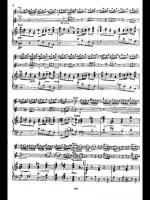

The melody line is more complex than the Vivaldi concertos and takes more time to memorize, but there are not too many daunting technical difficulties to surmount. In a bold move, Suzuki placed violin II of the 1st movement at the end of Volume 4, perhaps using its allure to inspire students to overcome the challenges of learning. The voices of two violins intertwine in a fugue of matchless invention: from Bach’s musical imagination and mastery came a timeless wonder. The Concerto for 2 Violins, Strings and Continuo in D Minor or Bach Double Concerto (jokingly called the Dark Bubble) is revered as the most perfect concerto of the baroque era. From this happy and productive period came the exuberant Brandenburg Concertos, the first book of the Well-tempered Clavier, the Orchestral Suites and many other important works. Johann Sebastian Bach composed this sublime concerto while employed at the court of Prince Leopold of Anhalt-Cöthen from 1717 to 1723. I’ll take these points one at a time: Read More →

When I joke, “ Volumes IX and X are easy books: only one piece each,” they always ask, “ How many pages do they have?“ Knowing a seven page piece is an impressive achievement.

Students like the fact that the 3rd movement is just one of three parts of a whole piece of music, to be performed at one time. And there’s an interesting twist to the story of that arpeggio section. What’s new here, technically speaking? This piece makes good use of 2nd position and features harmonics – neither exactly new to Book IV players, but common hereafter. The 3rd movement of the Concerto in A Minor is written in his trademark lively style, more of a challenge to learn and play than the 1st movement, for two reasons: firstly it’s a little quicker – Presto and secondly, there’s a tricky arpeggio section on page 2 (bars 75-90). Improving the Hard BitsĪntonio Vivaldi’s music is instantly recognizable and easily differentiated from his composer contemporaries, coloured with his unique Venetian flamboyance and flair. Laurie Niles, founder of the excellent site picks this up in her article on the piece here. Predictably, there has been controversy since about which version is the correct one to study and play. He added a piano accompaniment to his edition of the concerto, perhaps the reason it became so widely accepted. A bit of research revealed that Suzuki and many teachers of his time used an arrangement by Hungarian violinist Tivadar Nachéz (1859-1930). Nachéz, who lived most of his life in London, was also a composer and arranger. Years ago, listening to the 3rd movement on Swiss Classic Radio, I was surprised to hear Itzhak Perlman play a completely different arpeggio section than the version I had studied. In this post we finish our climb to the top, examining the arpeggio section in detail – the key problems and the strategies for overcoming them.īut before we go there, I want to tell a little story behind the edition of this concerto in Suzuki’s Volume IV. In my previous post about the 3rd movement of Vivaldi’s Concerto in A Minor, I ventured that it is more challenging than the 1st movement because of the quick tempo and the tricky arpeggio section on page 2.


 0 kommentar(er)
0 kommentar(er)
